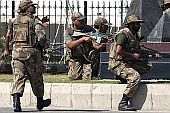 Pakistani authorities have arrested 20 people for their alleged links with the mastermind of the terror attack on army headquarters in Rawalpindi and formed a high-level police team to probe the audacious strike.
Pakistani authorities have arrested 20 people for their alleged links with the mastermind of the terror attack on army headquarters in Rawalpindi and formed a high-level police team to probe the audacious strike.
Aqeel alias Dr Usman, described as the mastermind of the attack by the authorities, was captured after being seriously injured in an explosion when commandos stormed an office of the Military Intelligence near the army headquarters to free hostages held by terrorists.
Thirty nine hostages were freed and four other terrorists killed during the operation.
Among the 20 people arrested are Mohammad Azam, the owner of the house on the outskirts of Islamabad where the terrorists had lived and planned the attack, and several persons from Rawalpindi and nearby areas who were in contact with the attackers or spoke to them on telephone on Saturday, media reports said.
Azam and real estate agent Abdul Raheem, who were involved in renting Azam's house at Model Town Humak to the terrorists, are in police custody in Rawalpindi.
During a search of the home, investigators found name plates used in army uniforms, army division signs, ribbons, army shoes, fuses for rocket-propelled grenades, detonators and anti-tank mine fuses.
The terrorist assault began on Saturday morning and five attackers and six soldiers, including a brigadier and a lieutenant colonel, were killed in the initial exchange of fire.
Residents of Model Town Humak have said they saw six to seven men dressed in army uniforms leaving the rented house in a white van on Saturday morning, hours before the attack began. The terrorists, who attacked the army headquarters, were disguised as soldiers and were travelling in a white van.
During another raid on a house on the outskirts of Rawalpindi yesterday, police arrested two men identified only as Sartaj and Sher Jan, both from North West Frontier Province. Police also seized two police uniforms, a camouflage military uniform and a 12-bore gun during the raid.
Police have formed a high-level investigation team led by Rawalpindi police chief Rao Mohammad Iqbal to probe the terrorist attack.
They also registered a First Information Report at a police station in Rawalpindi under the Anti-Terrorism Act and other laws.
Investigators have examined footage from close circuit TV cameras installed along the Mall Road, one of Rawalpindi's main thoroughfares. The footage showed that 10 gunmen disguised in army uniforms reached the heavily-fortified General Headquarters' first check post in a white van and tried to force their way towards the complex.
The footage showed that four terrorists fired on security personnel and lobbed grenades. Others took position ands started moving towards the headquarters, pretending as if they were soldiers battling the terrorists.
It has now emerged that the terrorists had taken over 50 hostages at the Military Intelligence office.
Nine hostages, including two officers, managed to sneak out of the building on Saturday night after authorities cut off power to the area. They provided crucial information about the position of the terrorists within the building.
Commandos rescued 39 hostages during the rescue operation launched at 6 am local time yesterday. Chief military spokesman Maj Gen Athar Abbas had initially said 42 hostages were freed. Three hostages were shot dead by the terrorists.
Two commandos of the elite Special Service Group were killed during the operation while five more were injured. Some of the hostages also sustained injuries.
Militant commander Aqeel had earlier served in the army's medical service. This was the reason why he was given the nickname "doctor". The militant commander has links to the banned Jaish-e-Mohammed and Harkat-ul-Ansar.
He was critically injured during the assault by commandos and three military doctors performed surgery on him to save his life as investigators are hoping to glean vital clues from him.
The News daily reported that the attackers, who were carrying food and supplies that would have enabled them to hold out for up to five days, had plans to take some Generals hostage if they had been able to storm the army headquarters.





